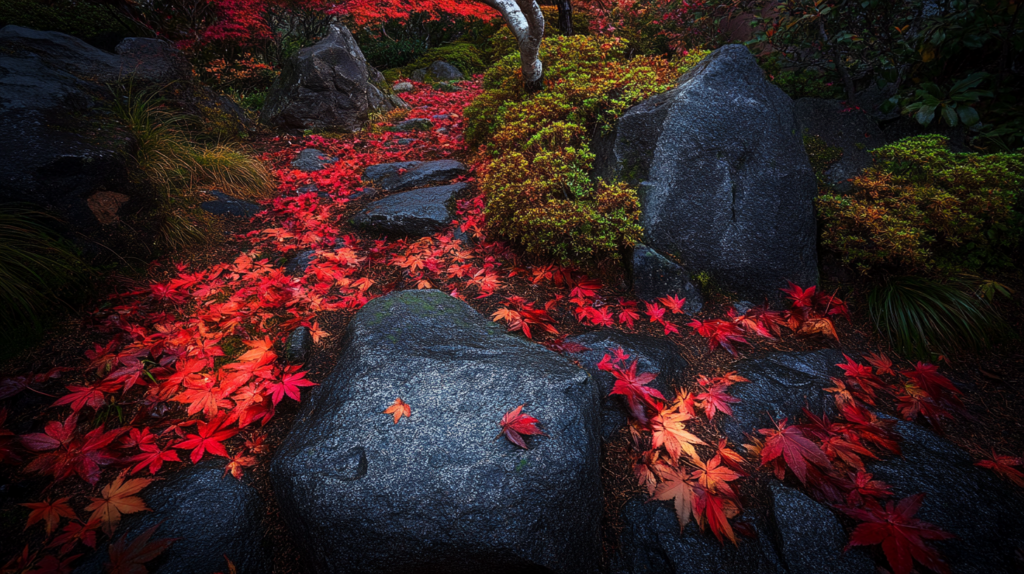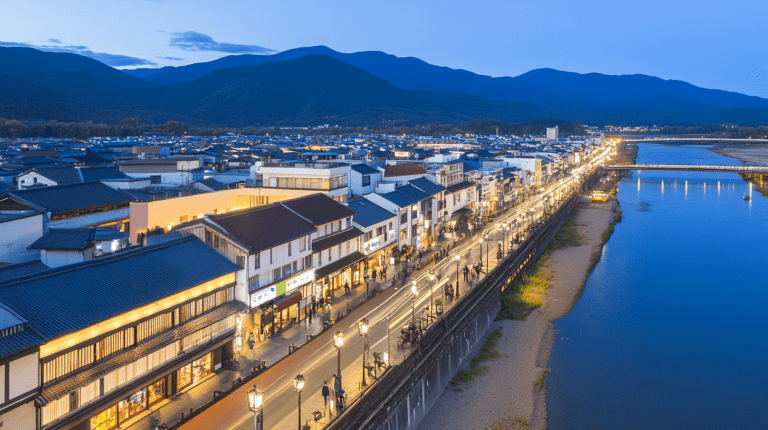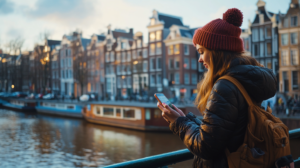Hi there! Welcome to my slightly absurd yet utterly amazing journey through the magical city of Kyoto, made infinitely smoother—and often more amusing—thanks to my digital travel buddy: Google Trip Planner. This wonderful app, which I have now emotionally bonded with, knows me better than I know myself. It’s like having a best friend who not only gives you great travel advice but also makes sure you’re never stuck in a 500-person line to see something like, well, a temple you’re not sure you even care about.
So, buckle up for the ride as I take you through four days of temples, food, gardens, and a series of events that made me question whether Google is actually powered by wizards.

Introduction
Picture this: You’re standing in the middle of Kyoto, overwhelmed by the sheer beauty and volume of temples, shrines, and matcha-flavored everything. You want to see it all, but there’s only one problem—so does every other tourist in the world. Enter Google Trip Planner, your personal genie in an app (minus the three wishes). It helps you navigate through Kyoto’s treasures like a local who can also read your mind. Need to avoid the tourist swarms? Google’s got you. Hungry for udon but also want to squeeze in a zen garden visit? Covered. Want to visit a shrine where you can befriend a local cat? Weird, but okay—Google probably knows one.
Here’s a breakdown of my whimsical, chaotic, and absolutely fantastic journey through Kyoto, all courtesy of the magic that is Google Trip Planner.
Detailed Daily Itinerary
Day 1: Diving into the Heart of Kyoto
Let’s set the stage for Day 1. I arrive in Kyoto, wide-eyed and over-caffeinated (thank you, Tokyo train coffee) and head straight for the crown jewel: Kinkaku-ji—the Golden Pavilion. Now, had I done this the old-fashioned way (aka without my trusty Google Trip Planner), I’d have been elbowing my way through mobs of selfie sticks. But no, Google saved me. It knew exactly when to send me there, at the perfectly obscure hour when most tourists were still at breakfast, thereby allowing me to take in the gleaming, golden temple in peace. Pro tip: Always trust Google Trip Planner to know when people are too busy eating pancakes to ruin your Instagram shot.
After marveling at Kinkaku-ji, I decided to trust Google to find me a quaint café for some afternoon matcha. Now, here’s where the planner showed off its AI wizardry. It suggested this tiny, centuries-old tea house nestled between two towering temples, and when I say it was quaint, I mean it. It was so quaint that I didn’t even see it at first. But, once inside, I found myself sipping matcha while gazing out over a perfectly manicured rock garden. The whole thing felt so serene and picturesque that I wondered if I had accidentally stepped into a Miyazaki film. I half-expected a forest spirit to pop out and share my tea.
Day 2: A Stroll Through Time
Day 2 was all about temples and time travel. Not actual time travel, mind you (Google hasn’t figured that out yet, sadly), but the kind where you walk around Kyoto’s ancient temples and feel like you’ve been transported back a few hundred years. I started with the world-famous Fushimi Inari Shrine, and because Google is not only wise but also kind, it scheduled my visit for the early morning. Picture this: rows upon rows of bright red torii gates with not a single tourist in sight—just me and a path that felt like it was leading me into some kind of ancient samurai showdown. The planner really outdid itself here by sending me during the shrine’s peaceful hours when even the shrine cats hadn’t fully woken up.
After feeling all Zen and victorious, I wandered off to Tofuku-ji Temple, another gem that my digital buddy insisted I visit. Google’s recommendation here was spot-on: Tofuku-ji is a sprawling complex famous for its autumn colors, though it’s an underrated stop most tourists miss. The best part? The gardens! They’re the kind of serene and meticulously raked places where you ponder life’s biggest mysteries, like why everyone in Japan walks so much faster than I do. While I was lost in thought, Google (yes, I’m speaking of it as if it’s a person now) sent me a friendly reminder to grab lunch before my stomach reminded me more aggressively. It directed me to a small restaurant nearby that served up bowls of udon so good I momentarily forgot how to use chopsticks.
Day 3: Culinary Explorations (aka Stuffing My Face)
By Day 3, it became clear that Google Trip Planner knows me on a soul level, and today, it had one goal: feeding me like I was a sumo wrestler preparing for a championship bout. We started the day with a street food crawl, beginning at the Nishiki Market, otherwise known as “Kyoto’s Kitchen.” The planner guided me through the stalls like a pro, highlighting must-try items such as takoyaki (octopus balls), matcha-flavored everything (I’m not kidding), and freshly grilled yakitori skewers.
In between bites, Google suggested I visit the famous Gion District, where I tried my hardest to spot a geisha without looking like a total tourist. Gion was magical, and walking its cobblestone streets made me feel like I’d stepped back in time—except, you know, with my smartphone in hand and GPS turned on. After an afternoon of wandering through traditional wooden machiya houses, I knew it was time for dinner. Google, ever the attentive travel companion, directed me to a hidden gem near Fushimi Inari Shrine. This tiny restaurant served up a traditional kaiseki meal—a multi-course feast that made me feel both fancy and uncomfortably full. The restaurant was recommended based on my clear love of food, and boy, did it deliver.
After dinner, I strolled along the path of the shrine’s torii gates again, only this time under the soft glow of lanterns. It was eerily beautiful and made me want to thank Google for being my personal time-traveling chef and guide.
Day 4: Modern Kyoto with a Twist of Tradition
By Day 4, I was convinced that Google Trip Planner had somehow crawled into my brain and taken up residence. This was the day I indulged my inner geek, as the app took me straight to the Kyoto International Manga Museum. If you’re even remotely interested in anime, manga, or comics, this place is heaven. It’s a manga lover’s dream, with floor-to-ceiling shelves of comics that you’re free to read at your leisure. I spent a good portion of the morning lounging in their reading room, getting lost in the pages of classic Japanese comics and occasionally trying to convince myself that I didn’t need to buy an extra suitcase just for manga.
But Google wasn’t done with me yet. Oh no. It had one final trick up its sleeve, and this one was as hands-on as it gets: a yuzen dyeing workshop. In case you’re wondering, that’s the art of painting traditional Japanese kimono fabrics using vibrant, intricate designs. I walked into the workshop with zero knowledge of fabric dyeing and walked out with a hand-painted masterpiece that I’m pretty sure the instructor secretly fixed while I wasn’t looking. It was an unexpectedly delightful way to blend modern creativity with traditional craftsmanship, and I couldn’t stop marveling at the fact that Google had known I’d love it before I even knew it existed.
Latest Travel Tips for Kyoto in 2024
As I relive my 2023 trip, it’s only fair to give you a heads-up on what to expect in 2024. Kyoto is a place where tradition meets technology, and that means some fun, new travel experiences:
- Smarter Crowds: In 2024, Google Trip Planner has gotten even better at predicting crowd levels. With even more accurate data on tourist hotspots, it will help you dodge those massive tour groups with laser precision. You’ll have temples all to yourself while everyone else fights for a photo op at the busier spots.
- Increased Sustainability Efforts: Kyoto has ramped up its efforts to protect its cultural sites and environment. Expect more eco-friendly travel options, including electric rickshaws and bamboo chopsticks that you can recycle into tiny Zen gardens. (Okay, that last part isn’t true, but wouldn’t it be cool?)
- Tech Integration in Temples: Several temples are experimenting with augmented reality. Imagine visiting a historical site and seeing holographic monks show you how life was centuries ago. Yep, we’re living in the future, folks.
- More Matcha, Please: Kyoto’s love affair with matcha is not slowing down. In 2024, new matcha-themed cafes are popping up everywhere. My personal recommendation? Try the matcha tiramisu—it’s life-changing.
Conclusion
This wasn’t just a trip to Kyoto; it was a finely tuned adventure, personalized to my every whim and curiosity, all thanks to Google Trip Planner. From peaceful temples to mouth-watering street food, the app didn’t just plan my trip—it elevated it, turning a regular vacation into something almost magical. It felt like having a local guide who knew me better than my closest friends and had access to every hidden corner of Kyoto.
As I left Kyoto, full of fond memories (and maybe too much udon), I realized that exploring with a digital guide can be every bit as fun—and sometimes even more rewarding—than the real thing. So, when you head to Kyoto in 2024, make sure to bring along your new best friend, Google Trip Planner, and prepare to be amazed.
TL;DR
If you’re planning a trip and need a bespoke itinerary that feels personally crafted, don’t overlook Google Trip Planner. It’s like having a friend in every city.
Further Reading
- Travel Moments – Your guide to creating memorable journeys.
- Adventure Insider – For those who live for discovering the unknown.
- Cultural Travels – Explore the heritage and history of destinations worldwide.
Closing Remark
That’s a wrap on my Kyoto adventure with Google Trip Planner. Ready to plan your next trip? Visit EasyTrip.AI for more information on how you can travel smarter and more tailored to your tastes!
FAQ Section
What makes Google Trip Planner different from other travel apps?
Google Trip Planner excels in integrating vast amounts of data to offer personalized travel suggestions that align closely with your preferences.
How does Google Trip Planner handle sudden changes in travel plans?
It’s pretty flexible; you can adjust your preferences on the go, and the planner updates your itinerary instantly.
Can Google Trip Planner handle bookings for hotels and flights?
While it primarily suggests itineraries, linking directly to booking sites is seamless, making the entire travel planning process a breeze.



